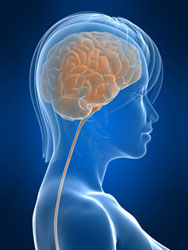Archived Content
The National Institute of Mental Health archives materials that are over 4 years old and no longer being updated. The content on this page is provided for historical reference purposes only and may not reflect current knowledge or information.
HIV Variants in Spinal Fluid May Hold Clues in Development of HIV-related Dementia
• Science Update

NIMH-funded researchers found two variants of HIV in the cerebrospinal fluid (CSF) of infected study participants that were genetically distinct from the viral variants found in the participants’ blood. The study, published October 6, 2011, in the journal PLoS Pathogens, suggests these CSF variants may help to inform research on the development and treatment of cognitive problems related to HIV infection.
Background
The advent of antiretroviral medications has helped many with HIV to manage the illness effectively. But even with proper treatment, a significant percentage of HIV-infected people develop HIV-associated dementia (HAD) or more mild neurological disorders. Research suggests that some people with HAD harbor variants of HIV in their cerebrospinal fluid (CSF) that may be less responsive to current treatments and thus contribute to cognitive decline. Understanding the role of HIV in HAD may also inform efforts to treat or prevent mild neurocognitive disorders associated with HIV.
To explore this issue, Ronald Swanstrom, Ph.D., of the University of North Carolina at Chapel Hill, and colleagues collected samples of blood and CSF from 11 people with HIV. All samples were collected just before and shortly after the person started antiretroviral therapy. The researchers also had access to additional samples from two of the 11 participants, collected several years prior to their starting treatment.
Results of the Study
The researchers found two variants of HIV in participants’ CSF that were genetically distinct from HIV found in their blood. Among participants diagnosed with HAD, the HIV variants in CSF showed greater genetic differences from the type of HIV in their blood, compared with participants with no HAD symptoms.
HIV typically targets a type of immune cell called T-cells. However, researchers found that one CSF variant replicated in macrophages, a different type of immune cell that typically lives longer than T-cells. In one of the participants with longer-term data, the researchers found evidence of this variant before the participant was diagnosed with HAD. During that time, the participant’s neurological assessments reported only mild impairment. The proportion of macrophage-targeting variants in the CSF increased over time, particularly in the first month after the participant was diagnosed with HAD.
In the other participant with longer-term data, the researchers noted the presence of the second CSF variant, which targeted T-cells, after the participant was diagnosed with HAD. Before the participant was diagnosed with HAD, the T-cell-targeting variant was not present in CSF samples.
Significance
The findings indicate that the genetically distinct variants of HIV in the CSF may each play a role in the development of HAD and related neurological disorders.
According to the researchers, the variant that targets macrophages provides clues to how HIV may evolve in order to replicate in a new cell type. The presence of the T-cell-targeting variant suggests that HIV infection may cause T-cells to migrate into the CSF. If confirmed, this migration would provide an alternative mechanism for maintaining viral replication in the central nervous system, which is associated with neurocognitive impairment.
What’s Next
Examining samples of blood, CSF, and brain tissue from a larger number of HIV- infected people with more mild symptoms of neurocognitive impairment may reveal physiological features that distinguish the two CSF variants identified in the current study. According to the researchers, identifying such features may help predict either current or future neurocognitive impairment and would emphasize the benefits of starting treatment early.
Reference
Schnell G, Joseph S, Spudich S, Price RW, Swanstrom. HIV-1 Replication in the Central nervous System Occurs in Two Distinct Cell Types . PLoS Pathog. 2011 Oct;7(10):e1002286
